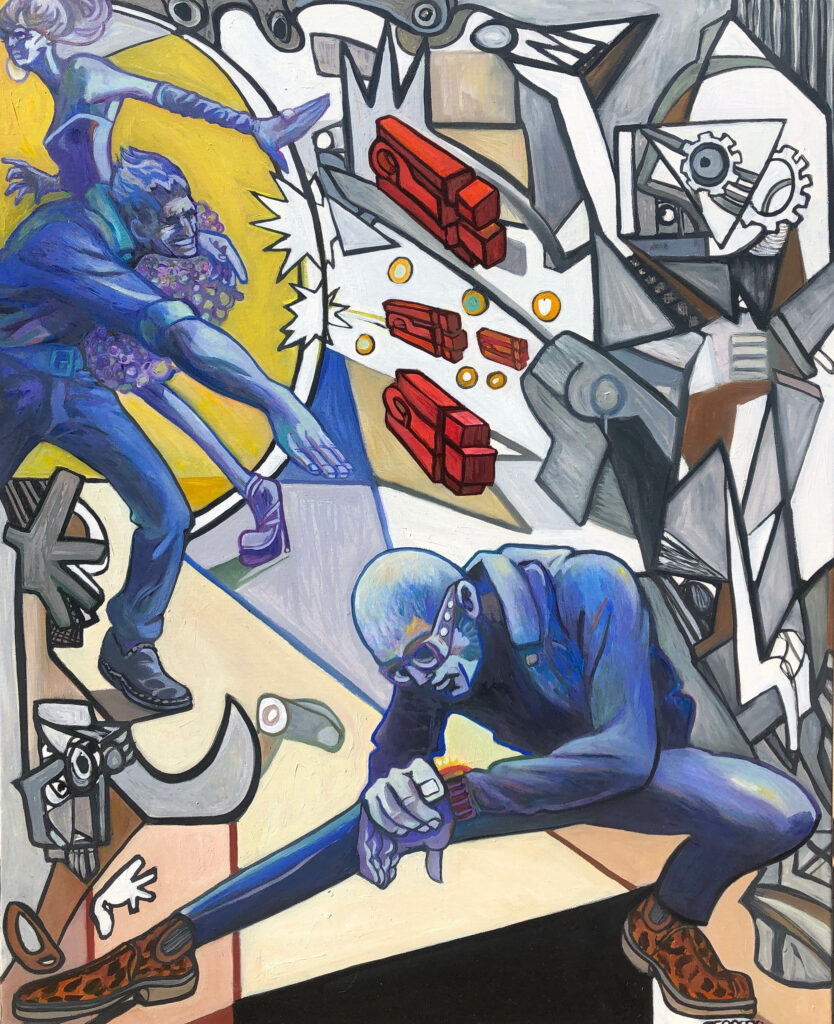
In the dazzling age of artificial intelligence (AI), where technological prowess seems to be redrawing the boundaries of the possible, one question remains at the heart of the artistic debate: can the machine rival the human in the realm of pure creation? As a contemporary painter and creator of the storytelling art movement, I wonder whether AI can match the emotional depth and authenticity of human art. This article proposes a reflection on the intrinsic limits of AI in artistic creation, highlighting the irreplaceable importance of human experience and emotion in the creative process.
Emotion, the Essence of Artistic Creation
At the heart of the creative act, the artist draws on a reservoir of lived experiences, experienced feelings and personal reflections. Each work is the expression of a moment, an emotion, a thought that, although transposed onto a canvas, in a sculpture or through music, remains profoundly human. This ability to feel, to live each moment to the full, to let oneself be overwhelmed by joy, sadness, love or anger, gives art its power and universality. Works of art are not simply aesthetic objects; they are a reflection of the artist's soul, a bridge between sensibilities.
Artificial Intelligence: Prowess without Soul
Artificial intelligence, for all its spectacular advances, operates within a framework defined by algorithms, data and predictive models. It can generate works that, at first glance, rival the complexity and beauty of human art. However, these creations are the product of calculations and trend analysis, not emotional experience. AI can imitate, reproduce and even surprise, but it lacks the ability to feel. It doesn't know the heartbeat that guides the artist's hand, nor the personal story behind each brushstroke.
The Inimitable Singularity of the Human Experience
Artistic creation is often the consequence of our experiences, our interactions and our perception of the world. It is intrinsically linked to our human condition, to our ability to give meaning, to seek connection, to express our uniqueness. Each artist brings to the world their own unique vision, shaped by their history, travels, encounters and emotions. This wealth of perspectives is something that AI, for all its sophistication, cannot hope to imitate in its true essence.
Towards Creative Coexistence?
Artificial intelligence has its place in the art world, not as a rival, but as an additional tool at the artist's disposal. It can open up new avenues of exploration, offer unprecedented means of realization, and stimulate human creativity through unprecedented collaboration between man and machine. However, it is essential to recognize that AI cannot replace the very essence of artistic creation, rooted in human experience and emotional expression.
Art, in its purest expression, is a reflection of the human soul, a testimony to our ephemeral existence, our joys, our sorrows and our aspirations. While artificial intelligence can enrich the artistic landscape with its innovations, it cannot claim the emotional depth and singularity that characterize human work. As artists,
our role is to continue exploring, feeling and creating, ensuring that the essence of art remains a celebration of the human condition, with all that is unpredictable, fragile and magnificently unique about it.
To illustrate the point that artistic creation is intrinsically human and cannot be replicated in its full expression by artificial intelligence, the episode entitled "The General" from the cult series "The Prisoner" offers a striking parable. In this episode, a sophisticated machine, capable of absorbing and reciting knowledge at phenomenal speed, is presented as a revolutionary educational tool. However, despite its ability to store and retrieve information, the machine proves incapable of understanding or dealing with a fundamentally human question.
At the end of the episode, the machine, faced with a question it can't answer, literally explodes. The fatal question posed, which causes its destruction, is revealed to be of profoundly human simplicity and depth: "Why?". This question, so basic yet so complex, encapsulates the essence of the human quest for meaning, a quest that goes far beyond the mere accumulation of knowledge. It symbolizes our innate desire to understand not just the how, but the why of things, a process that involves emotion, intuition and lived experience.
This episode perfectly illustrates the thesis of this article: technology, however advanced, remains limited in the face of the complexity of human thought and creation. Art, in all its diversity, is the fruit of our ability to question, to feel and to express these questions and emotions. It reflects our quest for meaning, our need to connect with others on a deep, authentic level.
The destruction of the machine in "The General" serves as a powerful metaphor for the limitations of artificial intelligence in the realm of pure creation.
With this in mind, in my work and my graphic novel "The Empire of Acceleration", I introduce the symbol of the "Question Mark", which is not just an aesthetic motif but the standard-bearer of an intellectual resistance against technological acceleration.
#IA #art #storytelling